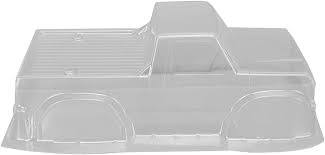The Importance of RC Bodies in Radio-Controlled Racing
When it comes to radio-controlled (RC) racing, enthusiasts know that every component plays a crucial role in the performance of their vehicles. One often overlooked but essential part of an RC car is the body. The RC body not only serves as a protective shell for the internal components but also significantly impacts the aerodynamics and overall handling of the car.
Aerodynamics and Performance
The design of an RC body plays a key role in determining the aerodynamic efficiency of the vehicle. A well-designed body can reduce drag, increase downforce, and improve overall stability at high speeds. These aerodynamic enhancements can lead to better cornering capabilities, faster acceleration, and improved overall performance on the track.
Customisation and Personalisation
RC bodies come in a wide variety of shapes, sizes, and designs, allowing racers to customise their vehicles to suit their preferences and racing style. Whether you prefer sleek touring car bodies for on-road racing or rugged off-road buggy shells for tackling rough terrain, there is a body available to match your needs.
Protection and Durability
Aside from its aerodynamic benefits, the RC body also serves as a protective shield for the delicate internal components of the car. In competitive racing environments where crashes are inevitable, a durable body can help absorb impact forces and prevent damage to vital parts such as the chassis, suspension, and electronics.
Expressing Individuality
For many RC enthusiasts, choosing a body is not just about performance but also about expressing their individuality and style. Some racers opt for replica bodies of real-life cars to emulate their favourite racing teams or drivers, while others prefer custom paint jobs and decals to make their vehicles stand out on the track.
Conclusion
In conclusion, RC bodies are more than just cosmetic shells for radio-controlled cars – they are integral components that influence performance, handling, protection, and personalisation. Choosing the right body for your RC vehicle can make a significant difference in your racing experience. So next time you hit the track, remember that your choice of body could be the key to unlocking your car’s full potential.
Understanding RC Bodies: Interchangeability, Materials, and Terminology
- Are RC bodies interchangeable?
- What does the RC stand for in racing?
- What are RC car bodies made of?
- What are RC parts made of?
Are RC bodies interchangeable?
When it comes to the interchangeability of RC bodies, the answer typically depends on the specific model and brand of the radio-controlled car. While some RC bodies are designed to be interchangeable across different models within the same brand or series, others may have unique dimensions and mounting configurations that make them incompatible with other vehicles. It is essential for RC enthusiasts to check compatibility specifications provided by manufacturers or consult with experts in the hobby to determine if a particular body can be interchanged with their specific RC car model.
What does the RC stand for in racing?
In the world of racing, the term “RC” stands for “Radio-Controlled.” In the context of RC bodies, it refers to vehicles that are controlled remotely using radio signals. RC racing enthusiasts use radio transmitters to operate their cars, trucks, planes, or boats from a distance. The precision and control offered by radio-controlled technology have made RC racing a popular and thrilling hobby for many individuals around the world.
What are RC car bodies made of?
RC car bodies are typically made of polycarbonate or lexan, which are lightweight yet durable materials commonly used in the manufacturing of radio-controlled vehicle bodies. These materials offer flexibility for shaping intricate designs while providing sufficient strength to withstand the rigours of RC racing. Polycarbonate bodies are known for their impact resistance and ability to be painted easily, allowing hobbyists to customise their vehicles with unique colours and designs. The versatility and performance characteristics of polycarbonate make it a popular choice among RC enthusiasts looking to balance aesthetics with functionality in their racing cars.
What are RC parts made of?
RC bodies are typically made of lightweight yet durable materials such as polycarbonate or lexan. These materials are popular choices due to their flexibility, impact resistance, and ease of customisation. Polycarbonate bodies can be easily painted and trimmed to achieve a desired look, allowing RC enthusiasts to personalise their vehicles according to their preferences. Additionally, the flexibility of these materials helps absorb impacts during crashes, protecting the internal components of the RC car. Overall, the choice of material for RC bodies plays a crucial role in determining not only the aesthetics but also the performance and durability of the vehicle on the track.

